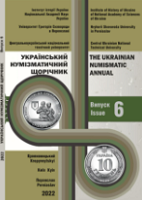«ЗНИКЛІ» СКАРБИ: ПРО ПРОБЛЕМУ ЗБЕРЕЖЕННЯ СКАРБІВ У ПОЗАМУЗЕЙНИХ ОРГАНІЗАЦІЯХ (ЗА МАТЕРІАЛАМИ ПІНСЬКОГО СКАРБУ 1962 Р. З ФОНДІВ НІМ РБ)
«DISAPPEARED» HOARDS: ABOUT THE PROBLEM OF CONSERVATION OF HOARDS IN OUTSIDE ORGANIZATIONS (ACCORDING TO THE MATERIALS OF THE PINSK HOARD 1962 FROM THE NHM RB FUNDS)
Author(s): Roman KrytsukSubject(s): Economic history, Post-War period (1950 - 1989)
Published by: ДВНЗ Переяслав-Хмельницький державний педагогічний університет імені Григорія Сковороди
Keywords: the disappearance of hoards; actual problems of legislation; depassportization; numismatics; Institute of History of the National Academy of Sciences of Belarus;
Summary/Abstract: For a long time, the need to study and publish hoards from museum collections was poorly touched upon by belarusian scientists and museum experts, both because of the absence of specialists and low level of interest in this topic. In the process of processing the hoard, the author faced a problem in the form of the loss of a part of the deposit, which eventually resulted in a separate article devoted to this topic. The aim of the study in this article is to introduce the 1962 Pinsk hoard into scientific circulation, as well as to reveal the history of the loss of a part of this deposit, in the context of the specifics of the development of archaeological science in the BSSR and the post-Soviet period. Research methodology. The scientific processing of the hoard complexes is not limited to just one description of them. The researcher can raise a series of questions – from the provenance of the deposit to the context of the hoard in the section of the history of the settlement where it was discovered and / or the history of the era and culture to which it belongs. In the process of studying this complex, analytical, logical and illustrative methods were used. Photographing and measuring technical parameters, editing photographs in graphic editors and establishing the correspondence of their characteristics with the description in previous publications were used as additional data for a comprehensive study of coins. Also, work with short publications and periodicals on the topic of the loss of archaeological and numismatic items was carried out. Due to the specifics of this topic, the but also on sometimes tendentious periodicals. Scientific novelty. The topic of the preservation and loss of hoards in non-museum organizations was not actually raised in national historiography. In some publications, there is information that the storage location of the hoard is unknown. But, the authors of these articles did not make the loss of the deposit the main topic of their work. Therefore, there are no scientific works devoted to this problem in Belarus. Conclusions. The loss of a part of the Pinsk hoard occurred as a result of a coincidence of circumstances that gradually formed over the years at the Institute of History of the National Academy of Sciences of Belarus (and in Soviet times at the Institute of History of the Academy of Sciences of the BSSR). Lack of a system of accounting and storage of materials, violation of the legislation of the Republic of Belarus in the field of protection of cultural heritage to the existing funds and unwillingness to put them in order and register, reluctance to remember the failures and annoying mistakes of the past – this is how the current state of affairs in this organization can be characterized. Probably, similar situations with archaeologically identified coin, coin-material and material complexes will be repeated many times in the future. The hoard itself, by its nature, probably belonged to a jeweler and was a collection of precious metal scrap. The time of the concealment of the treasure took place after 1632, and was possibly connected with the hostilities in 1648, when Pinsk was taken by the troops of Bohdan Khmelnitsky. Due to the lack of work in this direction, the prospects for further research are broad. The hoard from Pinsk is far from being a single hoard, divided in Soviet times between several organizations, or partially transferred to the museum. The issue of the loss of hoards and numismatic artifacts in the Soviet period in Belarus has not been investigated, as well as almost no legal issues related to the finds of treasures were raised. A promising topic is the loss (in view of theft or loss) of numismatic materials in the funds of Belarusian museums, since the latter was touched upon in a few publications.
Journal: Український Нумізматичний Щорічник
- Issue Year: 2022
- Issue No: 6
- Page Range: 314-330
- Page Count: 17
- Language: Ukrainian

